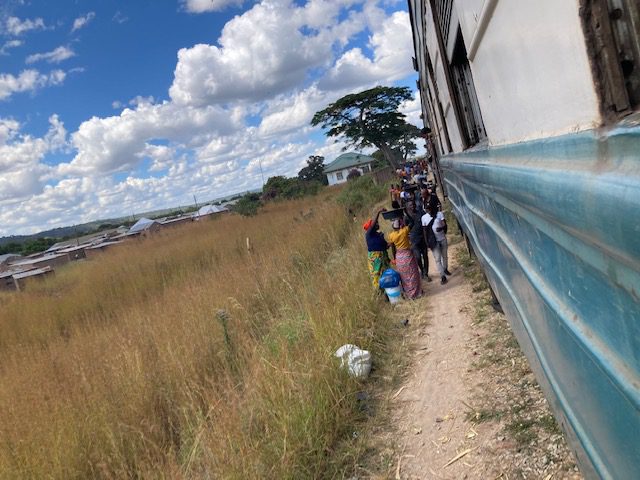There are two different Tazara trains. There is an older train leaving every Friday at 14:00 and an express train leaving every Tuesday from Kapiri Mposhi going to Dar es Salaam in Tanzania. You can read about how to get to Kapiri Mposhi by public transport here. I took the older train, which apparently is the Tanzanian one while the newer wagons, provided by a Chinese company, are from the Zambian side. So I thought my chances of actually getting to Tanzania might be higher with this one, especially after having heard from a fellow traveller that the express train had not gone all the way to Dar es Salaam a week earlier. I had phoned the Kapiri Mposhi station two weeks before to book a first class sleeper ticket. The number is: +260 978 721 782 and the woman on the phone was very helpful. The ticket for one bed was 736 Kwacha (~37€). Be aware that if you want to share a first class sleeper compartment with a person of another sex, you’ll have to buy up the whole cabin, i.e. 4 beds, to have the whole compartment for yourselves. Same-sex travellers are allowed to share their compartment with other travellers. Of course you can informally find other travellers to share a cabin.
I arrived at the Tazara train station in Kapiri Mposhi in the late morning to buy my ticket. Note that they only accept cash payment, at the station as well as on the train and for the Tanzanian visa on arrival. So you’ll also have to make sure to bring enough Kwacha to last you until the Tanzanian border for food and water. From that point onward, they will only accept Tanzanian Shilling in the train. I had tried to get hold of Tanzanian Shilling in Lusaka, but none of the banks had any. That was not a problem though, because as soon as the train rolled into the station in Tanzania where the border guards will also issue your visa and stamp your passport, there were plenty of money changers as well as SIM card vendors around. The exchange rate for Kwacha was not great, but also not the worst and there was really no other option, especially because apparently nobody will want to take your Kwacha outside of Zambia. I only had very little Kwacha left, so I also exchanged some US dollars for Shilling to be able to buy food and water on the train ride from the border to Dar es Salaam. There you get a much better rate for bills worth 50 USD or more. Considering that the ATM fee for getting cash is always quite high in Tanzania (around 8 euros), it’s not a bad idea to change US dollars for Shilling if you’ve got any.
Having bought my ticket for a first class sleeper, I was allowed to sit in the station’s VIP lounge while waiting for the Tazara train to depart – a very 80s style room with plush sofas and a toilet to use. I loved the atmosphere in the station. There was music playing, the hall looked like an empty indoors swimming pool that got fuller by the hour with fellow travellers, some bringing live chicken, mattresses, and so on. At 13.00 I was told we could board now and was shown my cabin by a train attendant. The train is quite long, so the first class sleeper wagons are usually not at the platform any more. I just mention that because the food vendors at the stations usually stay on or around the platform. So if you want to get a snack from the vendors outside, you’ll likely have to get off and walk towards the front of the train.
The first class sleeper is equipped with bedding, blankets and pillows. There is a shower and a squatting toilet. No toilet paper or soap though. They sell 1,5 litre bottles of water for 10 Kwacha (~0,5€) and then 1000 Shilling (~0,4€) and in the cafeteria wagon you can get breakfast, lunch and dinner, as well as ice cream. For first class, they even bring it to you if you want to. A meal is around 50 Kwacha (~2,5€), 65 (~3,3) for the fanciest one. On the menu for breakfast was toast, eggs and sausage with spaghetti. Lunch and dinner was either nshima/ugali (i.e. maize porridge), rice or chips with either chicken, beef or fish and relish (i.e. green vegetables and tomato stew). It was really tasty. You can buy additional snacks like fruit, fizzy drinks or fat cakes through the windows at some stations. What you should bring for the Tazara train journey? I’d say water, toilet paper, wipes, soap, a towel, some snacks, a good book.
The border crossing between Zambia and Tanzania was very smooth. We arrived at the Zambian border in the evening, got off and got our exit stamps at a small office at the train station. Then we boarded the train again to cross the border and stop again at the next Tanzanian station, where we got off again and got our visas and stamps in the train station hall by a nice border guard. I had read that some time ago, the border guards actually got on the train to issue visas and stamp passports, but this practice was discontinued because it took too long. The whole border crossing took maybe about 2 hours in total. After having received my visa in exchange for 50 USD cash, I boarded the train again and went to sleep.
I enjoyed the whole train ride a lot. Be aware that the train is quite shaky at times, which makes going to the toilet a little difficult, especially because you’re not allowed to go at stations because you’re basically peeing right onto the tracks, but that’s part of the experience. If you easily get sea sick that might be a problem though. Many windows of the train are broken, so you can stick your head out and enjoy the amazing landscapes passing by. I saw lush Tanzanian hills in the light of a full moon, arid landscapes splattered with villages and baobab trees, bridges and rivers, markets and so many excited little children waving at the train. In Tanzania, the landscapes are really impressive. The train even goes along the border of a national park where I spotted giraffes and antelopes. It’s almost like a train safari.
The train rolled into the Tazara train station in Dar es Salaam on Monday at 15.00. So the whole journey took 73 hours.
If you plan on taking the train from somewhere along the route, be prepared for a rather long wait because the schedule foresees the journey to take only two days, but this is apparently almost never achieved. It usually takes around three days, but can take up to 4 days. I’ve heard from a traveller who had to wait 14 hours for the train in Mbeya, which is perfectly normal because the train just gets more and more delayed as the journey goes on. So be flexible and minimally prepared (bring toilet paper and cash) and you’ll surely enjoy it greatly.

